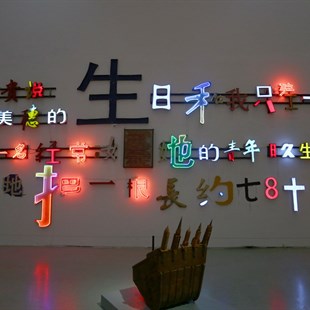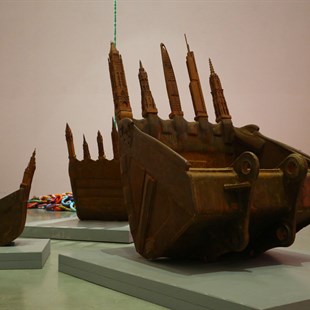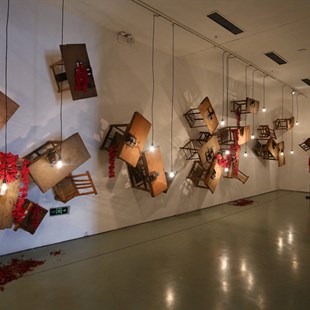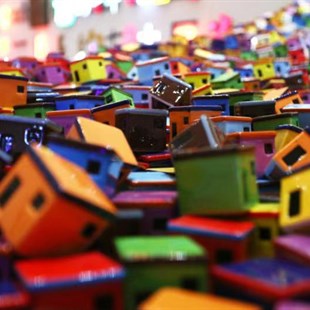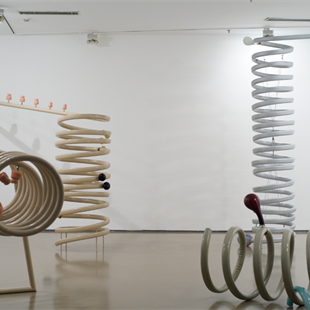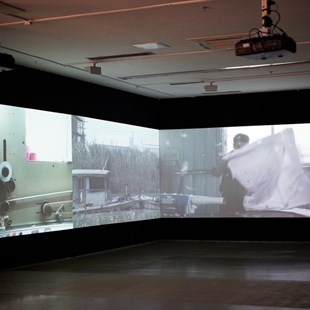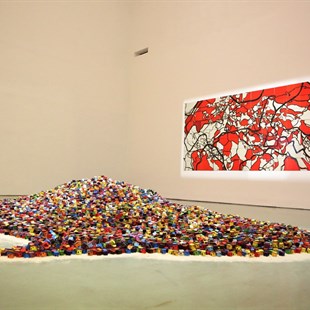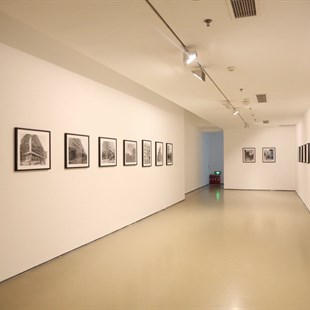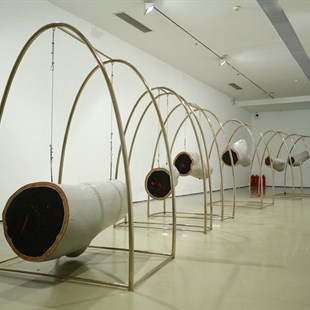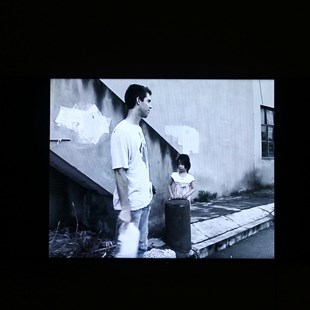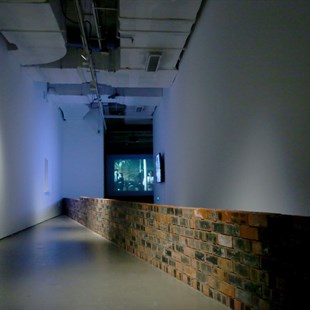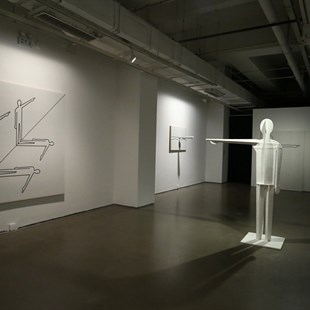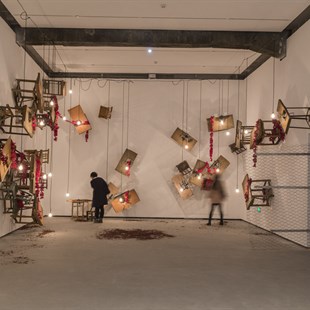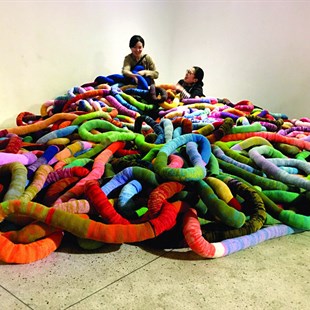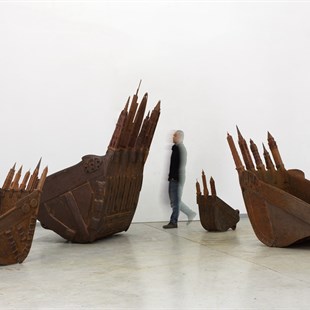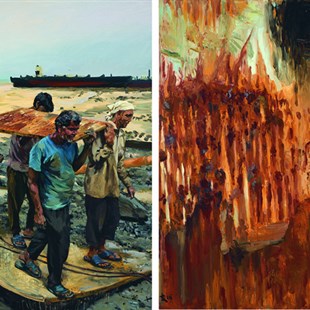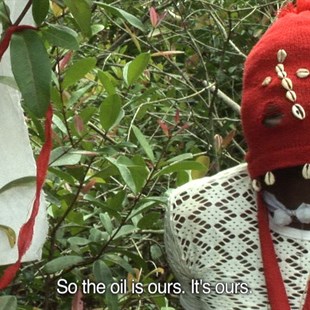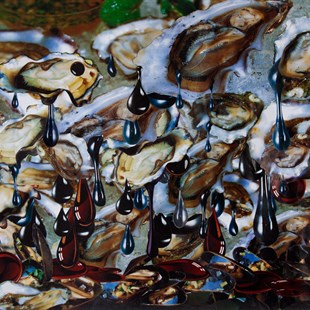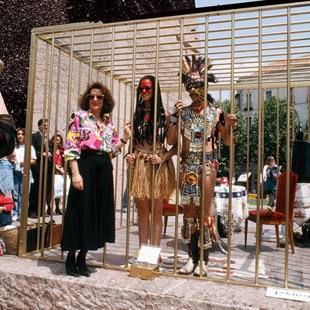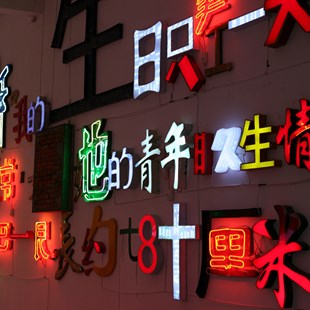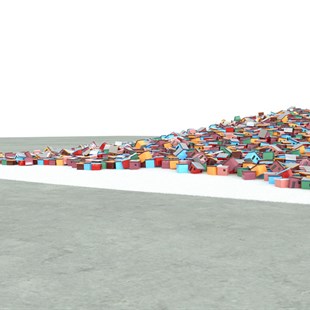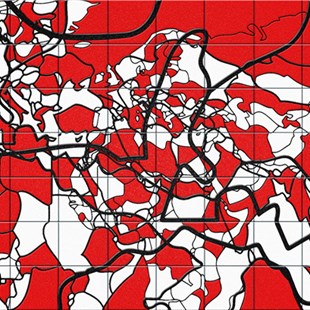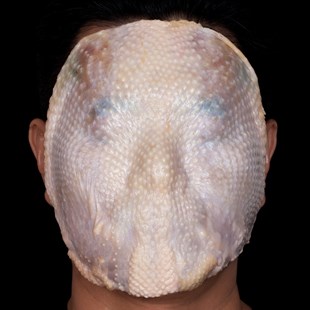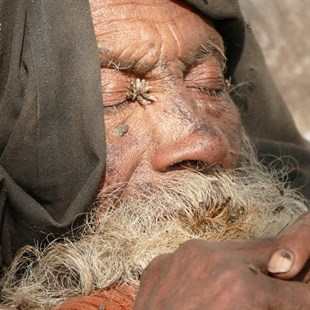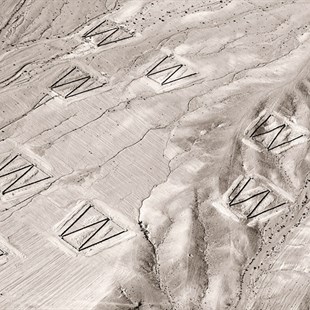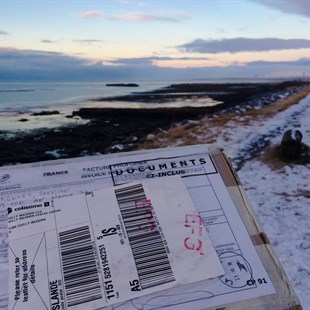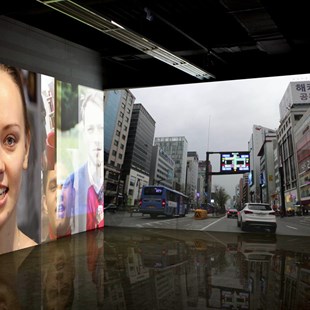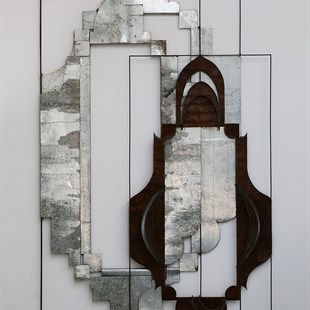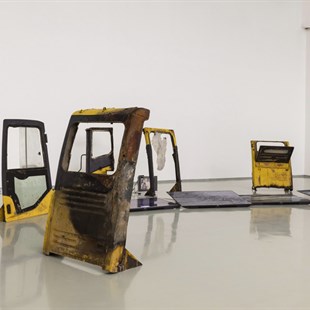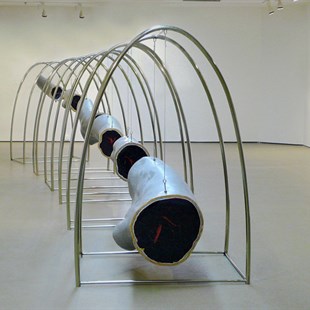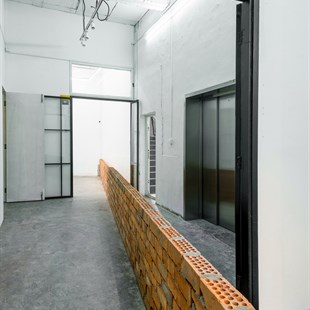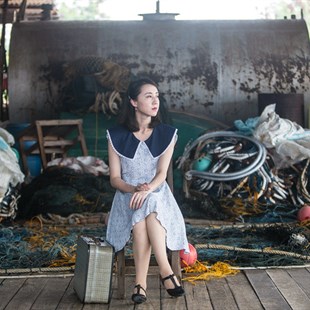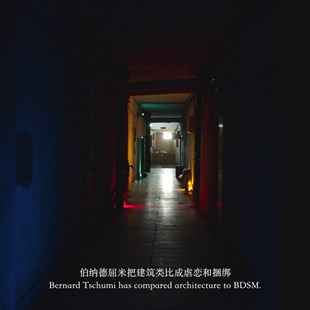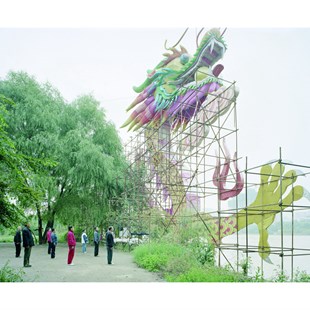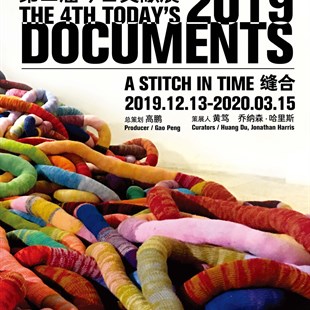
What is making the current world undergo fission? As a response, post-Marxist scholar Ernesto Laclau thinks that “Hegemony leads the integrative process of society but also leaves crevices of heterogeneity.”1 Perhaps, this explication with strong political implications is exactly the authentic portrayal of today’s world. If the fission of the world was inevitable, how could we “stitch up” the world’s wounds? As you walk into the exhibition hall of the 4th Today’s Documents in 2019, you can identify at least one reason to care about the world.
Today’s Today, Today’s Documents
The exhibition theme of the 4th Today’s Documents is “A Stitch in Time.” The introductory text to the exhibition has supplied two explanations of the theme. The first explanation aims to understand “A Stitch in Time” according to its literal meaning – “A Stitch in Time” originates from the English proverb “A Stitch in Time Saves Nine,” which suggests a remedy before things exacerbate, so that troubles and frustrations resulting from regrettable events could be avoided. This explanation emphasizes the role of contemporary art in reacting to such events before their exacerbation. The second explanation stems from post-Marxist scholar and famous Argentinian theorist Ernesto Laclau’s 1970s/80s theory of articulation, which addresses social and semantic dimensions of the world.2
The theme “A Stitch in Time” extends from its literal meaning to its deeper meaning; it forms a clear line of evidence for the curatorial concept while providing a shortcut for understanding the exhibition. To the curator, economics, politics, and culture are not the content to which the exhibition directs the audience’s attention. The revelation of art appearances is the protagonist of the narrative here. As much as the exhibition reminds one of Documenta in Kassel, Germany, in reality, it steadily engages with logics of art paths and practices. Whether the topic in contention within the exhibition is serious or lighthearted, as soon as it becomes represented through art, it will prompt endless imagination and reflection. This is the characteristic of Today’s Documents formed during its twelve-year course of development.
Today’s Documents is a recurring large-scale international triennial hosted by the Today Art Museum in Beijing. Since its first edition in 2007, the exhibition has been continually, based on conditions particular to China, discovered and elevated experimental and academic qualities belonging to Chinese contemporary art. In addition, it has acutely grasped trends of international contemporary art.3 In the twelve-year development of Today’s Documents, the exhibition has matured since its inception. The 4th Today’s Documents uses broader research perspectives to bring in deeper discussion relationships among art, artists, critics, and society. In what stance and with what responsibilities are today’s Today and Today’s Documents presented? Maybe one can only find answers to those questions at the site of the exhibition.
“Stitching up” Wounds or “Exposing” Truths?
Before one enters the exhibition, the curator mentions that the 4th Today’s Documents has invited more than thirty artists from different countries and regions. When you are about to experience fifty large-size artworks in one setting, your excitement and fear appear simultaneously. This is because the visual pleasure brought by artworks, following careful consideration, will bring to the fore the difficulty of thinking and reflection. After passing through a dark passage way, one enters the exhibition, which is opened with SHEN Yuan’s "Classroom Assignment". Wooden desks and chairs are installed on the (three) walls facing you, with the desk surfaces at a perpendicular angle to the floor. The strong spatial illusion is enough to entice the audience, but upon closer inspection, it is noticed that, instead of the books and stationery that we are used to, firecrackers and a mechanical devices for making them are on each desk. A dim light bulb is hanging in front of every desk, implying a kind of unsettling truth. It turns out that these “desks” are firecracker workstations of child laborers. Thinking about who would stitch up the children’s wounds resulting from manufacture-related explosions makes one startled like hearing loud firecrackers going off.
The image on the main poster of the exhibition comes from the work "Project 1336: Life in the Lane". The presentation of the work in a gigantic exhibition hall endows the work with a vivid sense of life. Colorful yarn is woven into cords tens of meters in length and thicker than an arm; the cords are suspended from the ceiling and whirling on the floor, their intertwining colors that make the complicated process of weaving fade into oblivion. The artist Manish Lal Shrestha who created this work was born in Nepal. This artwork belongs to a community art project participated in by women and youths living in the mountainous area. Colored threads in their hands are like timelines of their lives, and the process of weaving weaves in life stories and growing moments. It is possible that the artist wants to let us know that the road of life is never straight but full of intricate articulations. The cords, when woven, stitch up growing pains.
In the exhibition hall, there are many installation artworks made of excavator buckets, which seem like nothing special from afar. However, just as one knows that they are not as simple as they seem, on closer inspection, it enables one to identify their deeper meanings. The work is titled "Things that Trigger and Cure Sadness"; this verse-like the title forms a sharp contrast with the cold and rusted steel objects. “Fangs” on the excavator buckets that are replaced with representations of skyscrapers. The huge “arms” have constructed the city buildings we live in, and every skyscraper is a conglomeration of wealth. Hence, the skyscrapers that have replaced the “fangs” are symbols of urban capital and power. In the process of urban development, great income gaps between people are ripped open by the “fangs” bit by bit. How could one cross the inescapable divide? How long does one have to wait before the answer shows up?
If you were able to experience all exhibition viewing paths of the fifty works at once, you might gradually feel like you are in the position of a God’s eye view, looking at artworks and thinking about the world. Would you feel that we seem to be in a complex, unstable world, which brings certain kinds of anxiety? Why is it that when we view diverse and sensory satisfying works, we acquire a feeling that awaits the “healing” and “stitching up” of worldly suffering? This is because artworks supply us with abundant appearances from around today’s world, but appearances tend to be the most unstable, the most unrecognizable, the most likely to generate impulses that lead to anxiety, and the most likely to confuse the nature of things. At the same time, when works present appearances, they also incite the audience to explore the nature of things. Because nature is stable and invisible, they require exploration and research.
From “Stitching,” “Articulation,” to “Deconstruction”
Physical human wounds require “stitching” for healing. But what do social “wounds” need for “stitching” for healing? This exhibition seems to attempt to use art to “stitch up” wounds of the human world. From a sociological perspective, the deeper meaning of the exhibition theme “A Stitch in Time” corresponds to the theory of articulation coined by the post-Marxist scholar and famous Argentinian theorist Ernesto Laclau in the 1970s and 1980s. “Articulation” is an act that links together different and independent things, specifically disparate and unrelated languages, concepts, ideologies, experiences, values, desires, and people. From there, the exhibition theme “A Stitch in Time” extends the meaning of “articulation” to one’s proactive participation and willing changes in society, using metaphorical or evocative methods to make ones invest themselves in subjects awaiting action, involvement, intervention, revelation, and changes.4 As “stitching” switches to “articulation,” the exhibition turns from narrating the world’s sufferings to redeeming proactively. This suggests that art, as a unique social ideology, can always find vitality from intersections among politics, economics and culture.
The works shown in the exhibition emphasizes issues and repercussions brought forth by world economics, politics and culture since the 1990s. The issues touched by the works, if classified according to certain concepts, mainly include: body-mind, nation-region, identity-origin, meaning-reference, idea-materiality, and local-global.5 These concepts either oppose or interrelate with each other. Not only do these issues present a status quo of today’s world, but they also reflect contradictions and divisions within the world under the status quo.
The oil painting "Steel 1" by LIU Xiaodong depicts the scene of workers moving steel panels in the Bangladeshi port city Chittagong. The workers are moving steel panels from abandoned ships; the dilapidated environment and the decrepit appearance of the workers make one worry about the workers’ future lives and fate. As a major port of Bangladesh, Chittagong used to be peaceful, but now terrorists appear from time to time; some places even ban the entry of foreigners. As a symbol of trade and globalization, the port becomes ripe with uneasiness and danger as it is manifested here. Who are enjoying the advantages of globalization and who are bearing the misery that globalization brings? Wounds and crevices that the global economic system brings forth cannot be sutured by artworks, but artworks make one aware of their existence.
The video work of Mark Boulos "All That Is Solid Melts into Air" is named after Marshall Berman’s book All That Is Solid Melts into Air: The Experience of Modernity. The video discusses issues related to petroleum, dematerialization, globalization, etc. It consists of two seemingly unrelated yet cross-cutting films. One of the films gives the story of a Nigerian guerilla that attempts to stop transnational capitalists from engulfing domestic oil resources because its members believe they are protected by deities. The other film tells of the initial phase of the economic crisis, how the global financial system gained huge profits by manipulating oil prices in the futures market.
Judging from the contents narrated by the video, we should recognize that the video does not directly reveal any historical truth but uses the belief systems held by two opposing parties to discuss something: the right to oil resources fought between financial speculators and aborigines. Through presenting to us the viewers most straightforward understandings of material conditions, the video indicates that people’s religious beliefs are not more metaphysical than financiers’ frenzied speculations. Besides, by documenting the indigenous people’s militarized struggle, this video challenges the contemporary tradition of “human-rights” documentaries, which focus on the pitiable and powerless victimhood of locals.6 The questions concerning modernity raised by Marshall Berman through Marx in his book are caged by the modern economic order, just like we are.
When artworks in the exhibition are dissecting the world from diverse perspectives, it should be advised that we don’t forget that the works are not created for this exhibition. Art breaks down global phenomena from various angles, but exhibitions reconstruct it through their themes.
References:
1: DENG, Yuanyi and Kaka Guo. Identity, Hegemony and Democracy: Laclau’s Reconstruction of Marx’s Class Theory. Journal of Liaoning University (Philosophy and Social Sciences Edition) 47, no. 6 (2019): 36–41.
2-4: Exhibition text, Today Art Museum.
5-6: Berman, Marshall. All That Is Solid Melts into Air: The Experience of Modernity. Translated by Dajian Xu and Ji Zhang. Beijing: Commercial Press, 2013.
Text by LIN Lu, translated by Jacob Zhicheng Zhang, edited by Sue/CAFA ART INFO
Images Provided by Today Art Museum.
Exhibition information:
Represented artists: Arts Territory Exchange (aTE, UK), Bashir Makhoul (Palestine), Christy Rupp (US), Coco Fusco & Paula Heredia (Cuba), Cody Choi (Korea), Glexis Novoa (Cuba), He An, Hu Weiyi, Hwang Jung-hoo (Korea), Jananne Al-Ani (Iraq), Jiang Zhi, Joana Hadjithomas and Khalil Joreige (Lebanon), Ju Ting, Lamia Joreige (Lebanon), Larissa Sansour (Palestine), Lee Mae-lee (Korea), Li Hongbo, Li Jinghu, Li Xiaofei, Liu Wei, Liu Xiaodong, Manish Lal Shrestha (Nepal), Mark Boulos (US), Ryuji Miyamoto (Japan), Qiu Anxiong, Shang Yang, Shao Yinong, Shen Yuan, Sherman Ong, Shi Yong, Tan Xun, Tian Longyu, Wang Luyan, Wang Tuo, Xiao Yu, Zhang Kechun, Zhang Yibei
The 4th Today’s Documents: “A Stitch in Time”
Host institution: Today Art Museum, Beijing
Sponsor institution: China National Arts Fund
Producer: Gao Peng
Curators: Huang Du, Jonathan Harris
Exhibition location: Today Art Museum Building No. 1, 2
Opening date: 2019.12.12, 3:30pm
Exhibition dates: 2019.12.13-2020.3.15
Address: Today Art Museum, Building No. 4, Pingguo Community, 32 Baiziwan Road, Chaoyang District, Beijing
Hours: Tuesday – Sunday: 10:00am – 18:00pm, No entry after 45 minutes before closing time
Photo Courtesy of Today Art Museum


